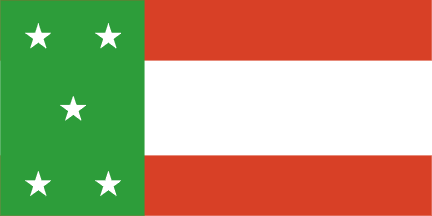
![[Non-official proportions]](../misc/_~~.gif)
![[Reconstruction]](../misc/oooooo.gif)
![[Reconstruction]](../misc/fis_reco.gif)
![[One or more variants under the same basic design]](../misc/fis_vari.gif)

Last modified: 2005-01-15 by juan manuel gabino villascán
Keywords: mexico | republic of yucatán | yucatán | barbachano | santa anna (antonio lópez) | centralist | federalist | separatism |
Links: FOTW homepage |
search |
disclaimer and copyright |
write us |
mirrors

|
1:2![[Non-official proportions]](../misc/_~~.gif) ![[Reconstruction]](../misc/oooooo.gif) ![[Reconstruction]](../misc/fis_reco.gif) ![[One or more variants under the same basic design]](../misc/fis_vari.gif)
|
| by Juan Manuel Gabino Villascán, May 06, 2001. |
"The most accurate version about the meaning of the five-star flag is that given by Historian Rodolfo Menéndez de la Peña, who wrote a brief introduction on the cover of the Serapio Baqueiro's book entitled 'Ensayo Histórico sobre las Revoluciones de Yucatán de 1840 a 1864' (Historic esay on the Yucatán revolutions from 1840 to 1864); the texts says: '...the Yucatán flag is divided into two fields: to the left, one field in green, and to the right, another divided in turn into three, red (top and bottom) and white (middle). The green area is featured by five beautiful stars standing for the five departments into wich Yucatán was administrativelly divided by Decree of November 30, 1840: Mérida, Izamal, Valladolid, Tekax and Campeche...' According the year on which the Peninsula was divided into five departments or districts, Writer José Antonio Adonay Cetina Sierra poits out another date in his work 'Apuntaciones para la Historia Legislativa del Municipio de Mérida' (Notes for the Legislative History of the Municipality of Mérida): 'It was then when Yucatán decreed on May 24, 1837 a new territorial division that reduced to five districts the then in effect colonial system; the town were distributed and in some cases the politic and administrative jurisdiction were enlarged: first district of Mérida, Department's capital; second district of Campeche; third district of Valladolid; fourth district of Izamal; and fifth district of Tekax'"
"Respecting the Yucatanense flag it was displayed by a short time at the Palace of the Government, according to Mr. Espejo, we count with the following information supplied by Writer Juan Francisco Molina Solís in his work "History of Yucatán" vol. 1; page 177: 'On night of March 16, 1841, during a meeting for the installation fo the Mérida Constitutional Council, the main room was invaded by an unarmed crowd, led by Barbachano, Francisco Martín Peraza and some others, asking for the full independence of Yucatán; then the Council under the crowd's presure agreed to review the proposal, (...) some of the most exitated people clang to the Palace's roof and after downining the Mexican flag hoisted that of Yucatan.' (...)""After six months (?) (it should be say -seven months-) and four days when the flag of Yucatán appeared, then October 20, 1841, the Congress of Yucatán proclaimed the Independence of the Peninusula from the Centralist Mexican Government, and starts to use the Peninsula flag as its symbol before the world nations, flying it at the merchant and military ships, as soon as the public buildings until December 15, 1843, when the Yucatanense government signs a Peace and Friendship Agreement with the Mexican counterpart, stating in the article 15 the following:
'Article 15: Yucatán shall not use any flag but that of the nation (...)'...".
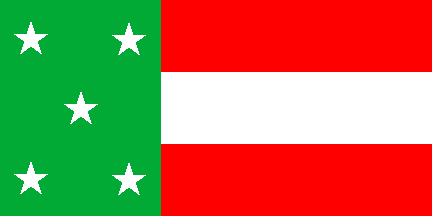 A
A
The flag is divided in two fields. The hoist side bears, to my
rough calculations (could only get an artistic rendition and photos
with no regular sizes) a bit more than a third of the flag; this is a
green field, with five white five-pointed stars, arranged 2-1-2 (from top to bottom).
The fly is divided in three stripes: upper and lower in dark red,
and a central and wider one in white. Again, the proportions
might be worng, but that's more or less what the flag looks like.
Today, it is extensively used by the Yucatan public, seen on t-shirts,
stickers and bumperstickers, sport jackets and so on.
Guillermo Aveledo, August 19, 2000
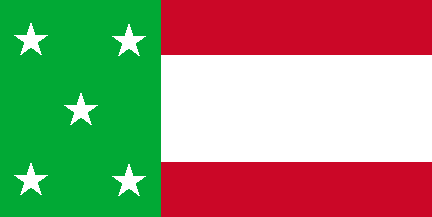 B
B
by António Martins, May 06, 2001.
I have had exactely the same problems. It appears that,
the flag of Yucatan is one of the most
popular unofficial flags of mexican states. I have visisted all web sites
refered here on this topic, and all show the same design with the wide
variation refered by Guillermo:
B
- The overall ratio varies from ~2:3 to ~1:3 or longer; I'd settle for 1:2.
- The shades are mostely bright, though one variation shows indeed the dark red shade used by Guillermo. I'd stick to medium red, though.
- The stars are mostely five-pointed, though at least one flag variation shows six-pointed stars. Five pointed would be the adequate choice for a "typical" Yucatan flag.
- The fly side stripes are almost always equal sized, but at least one flag variation shows 1+2+1 (spanish style). Again, equal sized stripes would be the adequate choice. - The green area varies also a lot: I've seen it from smaller than 1/3rd to almost one half. What would be the average? 2/5ths, perhaps?
António Martins, September 23, 2000
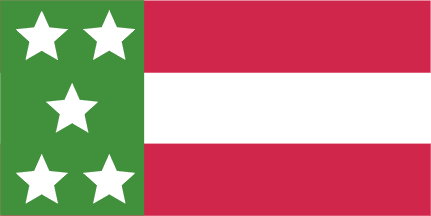
by Juan Manuel Gabino Villascán, May 06, 2001.
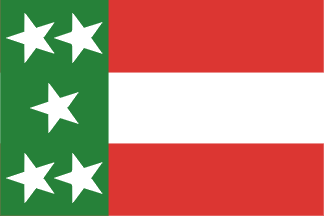
by Juan Manuel Gabino Villascán July 21, 2001,
based on the image sent by Carlos Magaña Lara on December 13, 2000
At present it is seen everywhere as part of a tourist
campaign of the state
government.
Carlos Magaña Lara on December 13, 2000